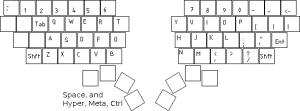A Configurable Keyboard
For a long time, I have hated the layout on all keyboards I’ve ever laid hands on. It’s not just that I prefer Dvorak to Qwerty; it’s that the slanting of the rows causes an awkward bending of the left wrist, that the space key is far too large when you only ever hit it in one spot; that of the keys such as Esc, Meta, Hyper, and Ctrl you can find a board which gets some right, but not all. For a long time I’ve pined for a keyboard with a layout like that depicted on the right.
I want a split keyboard, that slants the rows slightly, to favor of the natural angle at which your forearms approach anything directly in front of you. I removed the space, turning it into two individual normal-sized keys under resting position of the thumbs. Inside the thumbs arc we place the modifiers: Meta, Hyper and Ctrl. Although this might make Meta-Ctrl difficult to press (use a thumb for each), it does easily allow any of these three to be combined with Shift.
I am not the only one to have really specific demands as to the layout of my keys. Any internet search reveals many hackers with the same obsessions. Unfortunately, we each want a slightly different layout. Fortunately, we will actually pay a high price (because it’s actually a low price when amortized over a year of with use more than 4 hours every day) and we’ll spend the day to customize it.
There’s been a big advancement in multi-touch surfaces. So, you don’t actually need switches and circuitry to build a keyboard any more. Really, you just need a set of keys that can bang a point onto a multi-touch surface. The surface records an x,y position of the strike, and software takes care of the physical coordinate to key-code mapping. Multi-touch takes care of chording (a necessary feature for shift and other modifier keys).
My last idea of a multi-touch surface keyboard didn’t have any hardware for tactile feedback. But this one is different, we get to keep the tactile feel, because the physical stand-alone keys can be spring-buckling, scissor, or whatever: as long as it can bring down a strong point on the multi-touch surface.
Even if nobody ever picks up on the multi-touch surface keyboard, the above layout can still be mass produced as shown. I think most people will find it easy to adapt to.

